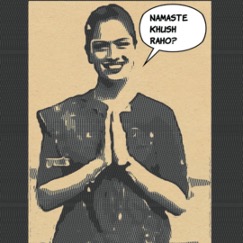Namaste is a very popular salutation today. In fact, I bet that every time you think of India you think of Diwali, dancing, and simple greetings, namaste.
Many people don’t know what it really means however and worse still, how to reply to it. If you are one of these people, keep reading this article and I will take you through it.
What Does It Mean When Someone Says Namaste To You?
Namaste is a very old greeting and it is very popular too. It has several meanings and can be used in many contexts to mean many things.
In the beginning, namaste, a Sanskrit greeting was said by the Hindus as a way to greet each other. It was just a mere greeting.
The Hindu culture believes that God dwells in each and every person and everything. Anything can be a God and has to be paid obeisance to. It is where this greeting originates from and it pays reverence to the deity in you.
It is also a customary greeting done with a light bow and hands placed close together close to the heart. It is called Añjali mudra, and it is a greeting of honor to the deity in you.
Here the literal meaning of namaste – I bow to you – is displayed. People also Namaste as a greeting to say hello, and goodbye, and even to close yoga classes.
It’s very popular now and many people that are not Indian or Hindu say it to themselves as a form of greeting while doing the Añjali.
Now that you know what it means when someone says namaste to you, here are replies you can use to respond:
8 Best Indian Responses to Namaste

Since namaste is in the Sanskrit language, why don’t we have some replies in the same language? If you are on tour, on vacation, visiting your foreign friends, or just speaking to them, you can use these replies.
Not only is it impressive to be able to say a few phrases in another language, but you will also get in their good graces quicker. Let’s see a few:
- Namaste
You can say namaste back when someone says namaste to you. Aside from being a way to acknowledge the divinity in a person, which means “I bow to you”, you say this as a salutation to people younger than you.
It is warm and simple and there is no way that you can mess this up.
- Namo namah
Namo Namah is another phrase you can use to respond to namaste. It, just like namaste, means I bow to you telling whoever you say this to that you are humble and loving.
You can use this the way you will use namaste. You can also say this while slightly bowing your head, waving your hand, or doing the Añjali mudra.
- Namaskāraḥ
For those that are older than you, use this instead of namaste. Namaste is not seen as very polite when you are greeting people older than you or people in authority like elders, bosses, and parents.
Here “Kara” means making, as in, making reverence to them. You can say this while doing the Añjali mudra or with one hand (preferably your right) to your heart.
- Sukhino bhava
This reply means “I wish you happiness”. Here it is a sort of wish. When someone says namaste you can use this for people younger than you to wish them well.
It’s a small prayer and it’s a good reply. You can use this in a more religious setting.
- Jeete Raho
This means God bless you. Here jeete means God so say it will reverence. You say it with care so they know you mean it and it’s you praying for them and meaning well for them.
You can say this to older people after they have done something nice to you and have said namaste but it’s more appropriate for people younger than you so you are not seen as rude.
- Namaste khush Raho
It means “be happy” and you can say this as a wish. You have to be careful though so you don’t say it to people who are older than you who will take offense.
You can say this in the Sanskrit language because, in English, it does flow as well as this.
- Namaste ji kaise ho
This means “how are you?” If you are speaking to someone who is your age, your friend, or who is younger than you, say on the streets or in a casual, freer setting, you can use this to reply.
It’s just like when someone says “hi” and you say “what’s up, how are you?” It’s friendly and from there you have a normal conversation in whatever language you choose.
- Pranaam
While this can be another gesture, it is also a greeting you reserve for spiritual leaders. It is known as the utmost greeting reserved for them so if you are on a tour to India and you just happen to visit a sacred place or holy temple, use this greeting to show respect.
12 Best English Responses

If you are not confident in saying the replies above, you can use these English replies below. As long as you are perfectly understood, you shouldn’t have any trouble. Here are some:
- Hello
Since namaste can be a simple greeting, you can reply with hello if you don’t want to say namaste in return.
You can say it as a casual reply to your friends, acquaintances, and people you are younger than.
You can also say hi. It all depends on how you relate to them and which one you are most comfortable using.
- Good morning/afternoon/evening
If you are speaking to someone older than you, you can use these simple greetings to respond to them when they say namaste.
Pick the appropriate greeting for the time of the day and you have no problem. You can choose to do a slight bow as a sign of respect.
- God bless you
Namaste can be used to greet the deity in people, as it is believed so you can use this as a reply if you don’t want to say namaste.
You might not feel comfortable saying namaste. It’s a language you don’t understand so this works better because it acknowledges the real meaning of the word and responds to it.
- Goodbye
Or just bye. You can say this if someone says namaste as a farewell greeting. Most yoga classes end with namaste and friends can call out namaste as they leave. You can say bye if you don’t want to use namaste.
- Greetings from this side
A little old and maybe something by a mysterious character out of a movie but it is okay to use.
If you are in a foreign place and you don’t want to take your chances with other replies because of the many different meanings, you can just say this to show that you are rendering salutations.
It’s a sign you respect them. Of course, it’s okay if they understand this and you don’t sound strange when you say it.
- Peace be unto you

This is a reply you can use in a religious setting. Many people greet namaste to honor someone, you can use this to bid them farewell as they go.
You can also say this after you meet them. If you like you can say namaste and still say peace be unto you. There are no rules to the good things you can say to people.
- And you too
Most people use this whenever they are not sure of what to reply. If the intent for saying this, based on meaning is not clear, you can say this too.
When you say it, smile so you don’t appear ignorant or frightened. Quick warning, don’t say the same to you.
It may seem okay but it doesn’t quite fit and as it can be more of an honorary greeting, it makes you sound ignorant.
- Shalom
Originating from the Hebrew language, this commonly means peace but it has other meanings like whole was, prosperity, and welfare.
Some people even use it as a greeting and it is a perfect reply to namaste regardless of the meaning.
If you are a Christian and you feel the whole “I bow to you” namaste meaning is against your doctrine, this reply is okay to use.
- You are welcome
In some yoga classes, people say namaste to mean thank you. It does not mean that namaste literally means thank you, it is just a friendly way to put it.
You can say “you are welcome” to acknowledge this and even smile. You can say “no problem” if you like but it shouldn’t get any more informal than that.
- May you find happiness
Good wishes not out of place with a lovely freeing as namaste. Imagine you had only a few seconds to speak to someone, this exchange will brighten their day, lift their spirits and make them happy.
It’s also something a yoga instructor will say so it’s okay for you to use this.
- Here?
This is a joke and not too many people will get it. Namaste sounds like “Nah, imma stay” which is saying you don’t want to leave the place.
If you ask them “here” it means you are questioning if they want to remain there. Did you get it?
Locals might think you are confused or silly even after they get the joke so just try this with your friends or anyone with a great sense of humor.
- Have a nice day
Let’s say you are parting ways with someone. If they say namaste to mean goodbye, you can say have a nice day. You can say namaste before you say have a nice day or say it alone, anyone you like.
It’s a friendly reply, especially to acquaintances, and it is acceptable to everyone.
5 Gestures As a Response

Gestures are a simple way to reply to namaste. It’s good if you are replying to strangers or if you are pressed for time.
Also, if you feel more comfortable replying with gestures than in the Sanskrit language, use these:
- A smile
Smiling can never go wrong. A smile shows that you have heard them and have accepted what they said, which is namaste.
- A wave
If you are not very conversant with an Añjali mudra, then you can do a small wave to acknowledge them. It’s good if you are saying goodbye to someone or accepting thanks for what you have done.
- A nod
If you are greeted by someone younger than you, you can use a nod as a silent acknowledgment. You will not nod to those older than you as they will see it as disrespectful.
- Añjali mudra
This is a non-contact gesture that people do when they say namaste. You do this by placing the palms together, close to the chest with the thumbs facing upwards and your head slightly bowed.
- Pranamasana
This is a yoga pose but it is also what I like to call a standing Añjali mudra. You do this by placing your palms together very close to your chest but you don’t bow.
You can do this with your eyes closed or with a smile. It is okay to do this with your friends and those younger than you.
Conclusion
Foreign greetings, especially those from parts with different meanings can be difficult to respond to because you can’t be too sure what they will mean, however with these answers you should have no problem at all.
Try to assess the situation to grasp the context of the greeting before you reply, this way you can’t make a mistake. Thank you and Namaste.